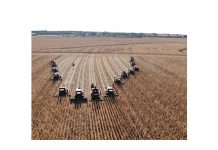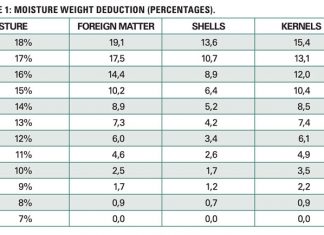There is clear evidence that agriculture in South Africa has evolved to take natural climate variation into account. The changing seasonal weather is such that two consecutive seasons are seldom similar. The response to variable amounts of rainfall, ranges in temperature and the seasonal shifts depend on the producers’ ability to adapt and be flexible in their planting dates, choice of crop and cultivar as well as their purchase and application of input resources, such as seeds, fertiliser, pesticides and herbicides. This climate resilience of producers can only protect them from variable weather, and can seldom prepare them for extreme weather.
It is therefore assumed by players in the agricultural industry that yields and prices will vary according to the local conditions as well as the free market principles that operate in the local and international markets. For this reason, producers understand that not every year will be profitable, but over the long run – all things being equal – the good years should outnumber the bad. But is the climate variability and risk changing? There is much anecdotal evidence suggesting that it is, but the scientific evidence is even more robust.
Increasing temperatures are a global risk to agriculture
So, what is changing and what can be done about it? Climate risk and climate resilience are two important concepts in this discussion. If the climate risk is increasing, then resilience must be built up through measured and effective responses. The most important climate change risk is increased temperature. This not only affects rainfall and seasonal patterns on the global scale, but also directly affects phenological and physical plant and animal growth as well as exposure to pests and diseases. Ultimately, it contributes directly to yield as well as creating post-harvest storage challenges.
And the temperature has been and is still increasing – in southern Africa more than the worldwide average. Increases of up to 1° over the last 100 years have been seen, which doesn’t sound like much, but has been averaged over an annual cycle. Individual station’s hottest daily temperatures have in some cases increased by 3° to 4° since records began (usually in the mid twentieth century). Rainfall patterns are very hard to analyse, as the trends are rarely statistically significant, but longer dry spells are seen. While the average rainfall may not be changing, the influence of higher temperatures leading to increased evaporation means that effective water availability is reduced.
Future projections are based on General Circulation Models, also named Global Climate Models. Although the temperature projections are unanimously pointing towards increases of between 2° to 5° by 2100 (compared to pre-industrial temperatures), they depend on the carbon emission pathway that is expected. There has been no real reduction in the rate of increase in CO2 emissions and thus the worst can be expected. Rainfall projections are loaded with uncertainty, but show broadly that the tropical and sub-tropical regions may experience more rainfall, with Mediterranean regions becoming dryer.
Impact on agriculture
Climate change’s impact on agriculture is clear. Crops are exposed to higher average temperatures, which many can endure, but it is the increase in extremely hot days (and warm nights) that can cause the most damage. The threat of changing rainfall seasons, leading to shifting rainfall onset/cessation dates, plays havoc with planting dates and crop management. Wide-ranging crop yield reductions may not affect a country with access to grain imports, but many countries with a large subsistence agricultural base face severe food shortage when crops fail.
The World Food Programme’s 2016 report shows that crop production yield per hectare is, on average, increasing at a rate below that of the global population. This implies that food production may be unable to meet global demand in the immediate future, leaving millions of people and numerous countries with reduced food security. To increase food production, yield per hectare must increase. This means that agricultural productivity must increase, post-harvest losses must be decreased and adequate market access must be available for sellers and buyers alike.
The dual nature of agriculture
South Africa has a dual agriculture economy, consisting of a well-developed commercial sector together with a smallholder, often subsistence, farming sector. While commercial farms occupy approximately 87% of the agricultural land, the small-scale farms of approximately two million smallholder or household producers occupy the remaining 13%.
Common constraints to successful small-scale and emerging commercial agriculture include lack of access to finance, challenges regarding land governance in the communal areas, access to water, the need for effective extension services as well as poor infrastructure, such as roads, electricity and access to markets.
Recommendations to increase climate resilience
To increase food production and uplift the agricultural industry, these challenges will need to be overcome, but it is important that the new and existing climate risks be considered at the same time. To this end, there are various recommendations. In order to increase climate resilience, producers should be encouraged to do the following:
- Reassess marginal crops. If crops have shown to be very drought sensitive and a combination of temperature increases and variable rainfall are an increased threat, then perhaps there are other crops that are more appropriate.
- Optimal seed cultivar selection for the forecasted seasonal climate conditions.
- Diversification is a way of spreading risk, but should also be used to test the potential of other activities and their latent income generation.
- The use of conservation agriculture techniques to conserve soil moisture, encourage soil health and reduce dependence on fertiliser and herbicides.
- Focus on reducing post-harvest losses through heat as well as excessive or unseasonal rainfall.
- Use a combination of crops and livestock to balance income and expenditure – especially during times of drought – in a financially sound way.
- Access climate information and become appropriately literate, so that seasonal climate forecasts can be used and applied.
- Liaise with other producers, academics and agricultural organisations to keep abreast of the latest developments.
It is also important to investigate the vulnerability of the entire agricultural value chain to climate risk, and to develop strategies to increase their resilience. A warmer world requires innovative and forward-thinking responses. It is important for academics, agricultural support organisations, input suppliers and government to work together and cooperate on this challenge.

















